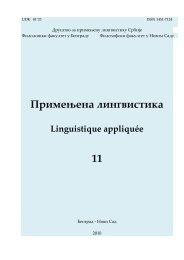Примењена лингвистика у част Ранку Бугарском - Језик у
Примењена лингвистика у част Ранку Бугарском - Језик у
Примењена лингвистика у част Ранку Бугарском - Језик у
You also want an ePaper? Increase the reach of your titles
YUMPU automatically turns print PDFs into web optimized ePapers that Google loves.
Tatjana Paunović: INTERCULTURAL COMMUNICATIVE COMPETENCE: ...<br />
sity, and ‘ethnorelative’ views in Bennett’s (1986, 1993) sense. The theoretical<br />
framework of the course included models of culture (Hall 1959, 1976, 2004;<br />
Trompenaars, Hampden-Turner 1998; Hofstede 1991/2005), the Developmental<br />
model of intercultural sensitivity (Bennett 1986, 1993), and defining the notion<br />
of ICC (Byram 1997; Byram et al. 2002, 2005), particularly in the context of EFL<br />
teaching. The anthropological perspective, offered, e.g. by Paxman (2007) and<br />
Fox (2004), was not explicitly included in the theoretical framework, but was<br />
suggested through the reading list and homework materials.<br />
Students’ work in the course was organized through group and individual<br />
activities that involved authentic materials (novel or story excerpts, newspaper<br />
and magazine articles, online written materials, comics, cartoons, video and audio<br />
materials from TV shows, films or online sources, live or online interviews<br />
with specific individuals), and were rooted in both ethnographic and critical approaches.<br />
For instance, in line with the ethnographic approach, students were<br />
required to closely observe, record, reflect on, analyse and explain cultural elements,<br />
components and meanings in specific contexts illustrated by the materials,<br />
and to report their observations either in writing, in their journal assignments, or<br />
orally, in class discussions. But in addition to this sort of reflection, and in line<br />
with the approach of critical pedagogy, they were encouraged to critically analyze<br />
these examples within the given communicative and social context. Special<br />
attention was paid to developing students’ awareness about the responsibility of<br />
socializations agents, and, particularly, language teachers as agents of socialization<br />
(Canagarajah 2005: 944).<br />
Assessment was, naturally, part of the course. Students’ journal entries<br />
were handed in regularly during the course, and assessed as individual projects.<br />
At the end of the course, students wrote individual essays (2,500 words) on the<br />
topic of their choice, which were assessed by the instructors. The final exam consisted<br />
in students’ oral presentations of their essays, followed by a group discussion,<br />
which was also assessed. However, it should be pointed out that students’<br />
final grades did not result from the assessment of their intercultural competence,<br />
but, rather, the language, organization and clarity of their written reports, based<br />
on general academic writing assessment standards, and their overall engagement<br />
in coursework and the final exam. The students did take a modified GENE (Generalized<br />
ethnocentrism scale) test before and after the course, the results of which<br />
showed some change of their overall stance towards ethnorelativism (reported<br />
in Lazarević 2009); however, it was not an assessment tool, but rather a selfreflection<br />
tool for students’ use. Much as Colvin-Burque and colleagues (2007:<br />
231), we felt that it was important to help the students develop the analytical and<br />
critical tools for observation and self-reflection, essential for their ICC, but that it<br />
238




